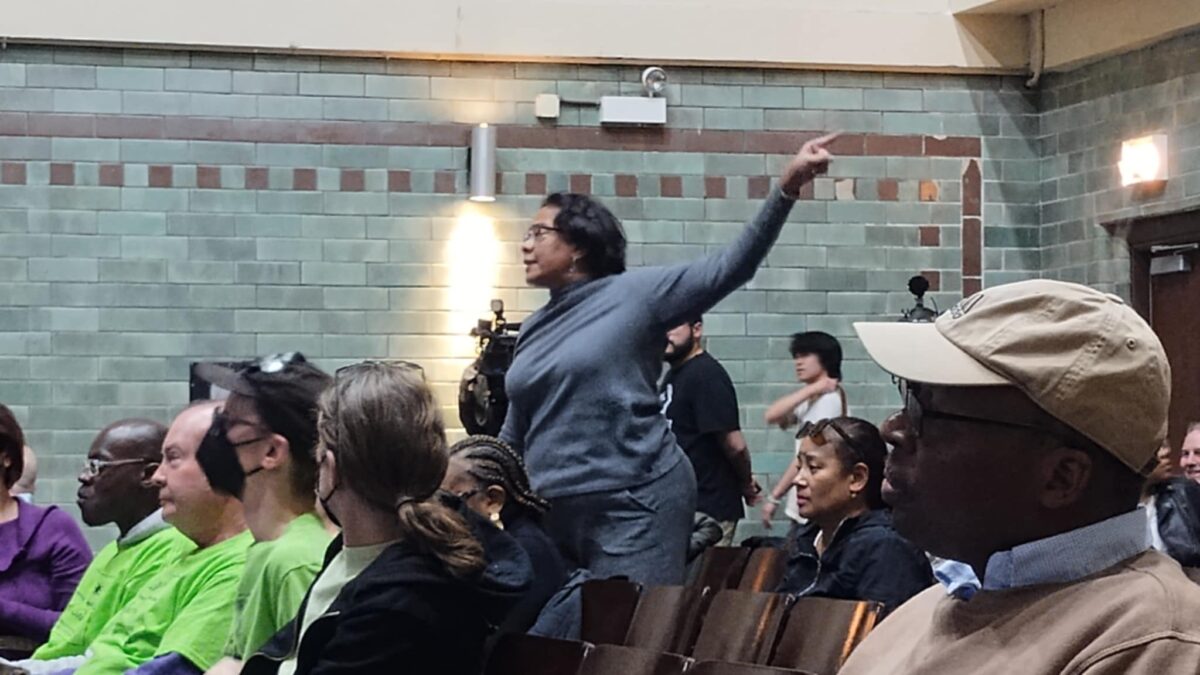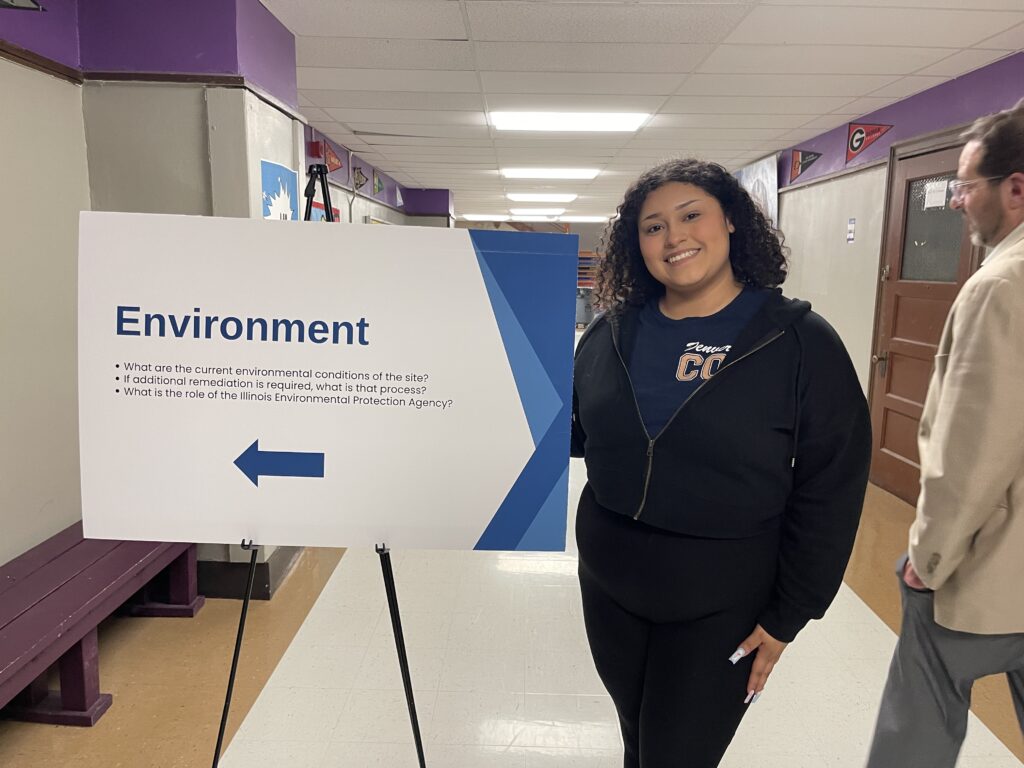Last Tuesday evening, several dozen people gathered in the auditorium at Bowen High School for another meeting on the proposed billion-dollar development of a quantum computer complex on the Southeast Side. The fifth city-led public meeting since August was disrupted by residents who refused to split into breakout rooms and requested their questions be addressed in the open, some chanting “Don’t poison us! Don’t displace us!”
“We get concerned when the people in the community who have been asking questions are getting met with the same answers at every single one of these meetings,” said twenty-three-year-old Isabela Jaimes. She pressed Tom Anderson, the meeting host and city’s economic development director, for more transparency.
The land hasn’t been acquired yet, Anderson said, but the PsiQuantum facility is expected to take up about 128 acres of the lakefront. Related Midwest, the developer behind the proposal, is also developing the USX site in parallel, which according to Crains, will take up an additional 312 acres near the Calumet River. Combined, residents fear they’ll lose access to the shore.
In a press release, Gov. Pritzker’s office said about 8080 S. DuSable Lake Shore Drive: “its strategic location will provide the water sources needed for cooling, and the site can accommodate the large power needs. The park is strategically located to take advantage of Illinois’ top tier infrastructure with interstate, rail and water access along with close proximity to partners including the University of Chicago and the Chicago Quantum Exchange (CQE).”
The Alliance of the Southeast (ASE) is a coalition working together to address the challenges facing the neighborhoods of the Southeast Side. They say the development has received rushed approval from all levels of government. “This construction and this project got pushed through, zoning got pushed through, the budget got pushed through, everything. And now, although groundbreaking has been pushed back, it’s happening less than a year after the project was announced,” Jaimes said.
When it was announced last summer, the state said it will provide $200 million to PsiQuantum. The state has also committed $300 million to build out the campus, the Illinois Quantum & Microelectronics Park (IQMP), to house a cryogenic facility and additional tenants.
Quantum computers use quantum bits, or qubits, to compute operations many times faster than traditional computers, which rely on binary 0’s and 1’s. A technology first established in the 1990s, scientists have since managed to create quantum computers with around 50-100 qubits, capable of outperforming supercomputers on certain calculations.
PsiQuantum claims it will build the U.S.’s first commercially useful computer with over 1 million qubits, a feat which may take years or decades to accomplish—if it’s even possible. The first phase of the development, approximately thirty acres, is set to be completed in 2027.
Anderson, unable to contain individuals who spoke up with or without a microphone, allowed a question-and-answer session for the rest of the meeting.
Felena Bunn said that, despite living down the street from the development site, she has not received mailers, phone calls, or door knocks related to the project. “My understanding is that they’re going to get this huge tax break for thirty years… I’m not getting that tax break… They should pay their taxes so that goes back into my community,” she said.
Multiple people at the meeting wanted the specifics on job creation because project managers have said 150 jobs will be created in the first five years, but not how many jobs will go to local residents, who are predominantly blue collar workers.
In a statement to the Weekly, a spokesperson cited a recent report from the CQE that found that about two-thirds of jobs in the quantum industry are open to those with a bachelor’s degree or less. However, an Illinois Answers Project evaluation found that opportunities for jobs for high school graduates in the quantum industry are very much limited.
Anderson touted a program for high school students they’re calling the Saturday Morning Quantum, a ten-week course designed by Fermilab for CPS students to equip them with the foundational knowledge to explore careers in quantum. “We are also working with City Colleges of Chicago, Chicago State University and other postsecondary institutions, who are represented on the IQMP’s Board of Managers, to build the talent pipeline and remove barriers for non-degree holders to enter the quantum workforce,” the IQPM spokesperson said.
Jaimes, who works with the Southeast Environmental Task Force and is a member of the South Works Coalition, said the industry will attract physicists and other industry insiders that could spur gentrification in the East Side neighborhood.
Further, there are environmental concerns that haven’t been substantially addressed. For example, there’s worry that the amount of power necessary to operate the machines could contribute to a heat island, and post-industrial South Chicago already has a significant heat index.
“My biggest concern when it comes to the lakefront, if they actually do discharge into a lake, is how the water would then be [affected]. We heard people fish along that lakefront all the time. But if algae blooms are happening, if heated water is killing the animals in that area, the water in that area is going to be subpar. Algae blooms are so detrimental to the ecosystems in a body of water. And we know that adding hot water into cold water like that increases the [probability] of that happening,” Jaimes said.
IQPM told the Weekly there will be no water pollution, and it is “increasingly likely that there will not be a need to draw water” from Lake Michigan or the Chicago River.
“All last year, they were saying, ‘We’re building this plane as we fly it,’ and that doesn’t give the community any certainty that what they say at one meeting won’t be completely different at the other,” Jaimes said, which is creating distrust rather than connection with the community, she said.
The Defense Advanced Research Projects Agency (DARPA), a Department of Defense technologies agency, said it will commit up to $140 million to its quantum proving ground, matched by $140 million from the state.
“People brought up questions about what this technology is actually going to be used for,” said a spokeswoman for Southside Together (SST), a South Shore-based group that has expressed skepticism toward the development. “Given that this is like a military technology facility, how much access folks will actually have to the parks that are around the facility? This is a primarily Black and brown community, and there’s [presumably] a super heavily policed facility right on the lakefront. Like, how much access will folks actually have?”
The former site of the U.S. Steel South Works once employed tens of thousands of residents and immigrants. Since its downsizing and eventual closure in 1992, multiple bids for development have not materialized. While the quantum park is supported by city, county, and state elected officials, nearby residents want to build upon their Community Benefits Agreement (CBA) published in 2017 with commitments in writing from Related Midwest or any potential developers.
Correction March 29, 2025: The Weekly incorrectly stated that a source was an ASE organizer. Their title has been updated, we apologize for the error.
Jacqueline Serrato is the Weekly’s editor-in-chief.



